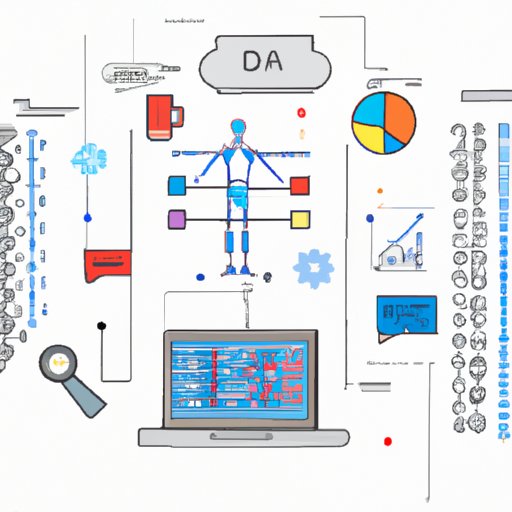Introduction
Data science is an interdisciplinary field that utilizes scientific methods, processes, algorithms, and systems to extract knowledge and insights from data. It combines elements from computer science, mathematics, statistics, and business intelligence to gain new insights from data. Data science has become increasingly important as organizations generate more and more data and look for ways to leverage it for their benefit.
A. Definition of Data Science
Data science is a broad term that encompasses many different activities. At its core, it involves collecting and organizing data from various sources, applying various techniques to analyze the data, and presenting the results in an understandable format. The goal of data science is to uncover patterns, correlations, and trends that can be used to make decisions or inform strategies. It also involves using predictive models and forecasting to anticipate future outcomes.
B. Overview of Data Science Applications
Data science can be applied to almost any industry or domain. It is especially useful in fields such as healthcare, finance, retail, marketing, and manufacturing. In healthcare, data science can be used to analyze patient records and medical images to diagnose diseases and develop treatments. In finance, data science can be used to detect fraud and assess risk. In retail, data science can be used to optimize pricing and inventory management. In marketing, data science can be used to identify customer segments and personalize campaigns. And in manufacturing, data science can be used to optimize production and reduce waste.

II. Tools and Technologies Used in Data Science Projects
Data science projects require various tools and technologies to collect, organize, and analyze data. Popular tools and technologies include data collection and analysis tools, machine learning tools, and data visualization tools.

A. Data Collection and Analysis
Data collection and analysis tools are used to gather and process data from multiple sources. These tools typically use a combination of data extraction, data warehousing, and data mining techniques to collect and organize data. Popular data collection and analysis tools include Hadoop, Apache Spark, and SAS.
B. Machine Learning Tools
Machine learning tools are used to build predictive models and forecast outcomes. These tools use algorithms to learn from data and make predictions. Popular machine learning tools include TensorFlow, Scikit-learn, and Keras.
C. Data Visualization
Data visualization tools are used to present data in an understandable format. These tools typically use charts, graphs, and maps to represent data in a visually appealing way. Popular data visualization tools include Tableau, Power BI, and D3.js.
III. Best Practices for Collecting, Organizing, and Analyzing Data
When working on data science projects, it is important to follow best practices for collecting, organizing, and analyzing data. These best practices include defining goals and objectives, developing a data strategy, utilizing automation, and ensuring quality control.

A. Defining Goals and Objectives
The first step in any data science project is to define the goals and objectives. This helps ensure that the project is focused on the right metrics and provides clarity on what needs to be accomplished. It is important to define measurable goals and objectives so that progress can be tracked and success can be measured.
B. Developing a Data Strategy
Once goals and objectives have been established, the next step is to develop a data strategy. This involves identifying the sources of data, deciding how to store and manage the data, and outlining the process for analyzing the data. A well-defined data strategy helps ensure that the data is organized and accessible and that the analysis is accurate and meaningful.
C. Utilizing Automation
Automation is an important part of any data science project. Automation can be used to streamline data collection, reduce manual errors, and save time. Automation can also help ensure consistency and accuracy in the data analysis process.
D. Ensuring Quality Control
Finally, it is important to ensure quality control throughout the data science process. Quality control involves verifying data accuracy, testing data integrity, and evaluating the results of the analysis. Quality control helps ensure that the data is reliable and that the results are valid.
IV. Case Studies on Successful Data Science Initiatives
To get a better understanding of how data science is being used in the real world, let’s take a look at three case studies on successful data science initiatives.
A. Example 1
The first example comes from the healthcare sector. A large hospital chain was looking for ways to reduce readmission rates. To do this, they used data science to analyze patient records and identify high-risk patients. They then implemented preventative measures such as providing additional monitoring and follow-up care. As a result, the hospital saw a 20% reduction in readmission rates.
B. Example 2
The second example comes from the retail sector. A major retailer was looking for ways to improve customer loyalty. To do this, they used data science to analyze customer purchase history and identify customer segments. They then implemented personalized marketing campaigns to target these customer segments. As a result, the retailer saw a 10% increase in customer loyalty.
C. Example 3
The third example comes from the manufacturing sector. A large manufacturer was looking for ways to optimize production. To do this, they used data science to analyze production data and identify areas for improvement. They then implemented automation and process improvements to reduce waste and increase efficiency. As a result, the manufacturer saw a 15% reduction in production costs.

V. Exploring Career Paths in Data Science
Data science is an emerging field with a wide range of career opportunities. The types of jobs available include data analyst, data engineer, data scientist, and machine learning engineer. Educational requirements vary depending on the job, but most positions require at least a bachelor’s degree in a related field. Professional certifications such as Certified Data Scientist (CDS) can also be beneficial.
VI. Conclusion
Data science is an interdisciplinary field that uses scientific methods, processes, algorithms, and systems to extract knowledge and insights from data. It can be applied to almost any industry or domain and is becoming increasingly important as organizations generate more and more data. This guide explored the applications of data science, tools and technologies used in projects, best practices for collecting and analyzing data, case studies, and career paths.
of Key Points
In summary, data science is an interdisciplinary field that uses scientific methods, processes, algorithms, and systems to extract knowledge and insights from data. It requires various tools and technologies to collect, organize, and analyze data, and there are best practices for collecting, organizing, and analyzing data. There are also a wide range of career paths available in data science, ranging from data analyst to data scientist.
B. Final Thoughts
Data science is an exciting and rapidly growing field. It offers a variety of potential applications and career paths, and the demand for skilled data scientists is only expected to grow in the coming years. If you’re interested in exploring what to do with data science, now is the perfect time to start learning.
(Note: Is this article not meeting your expectations? Do you have knowledge or insights to share? Unlock new opportunities and expand your reach by joining our authors team. Click Registration to join us and share your expertise with our readers.)
